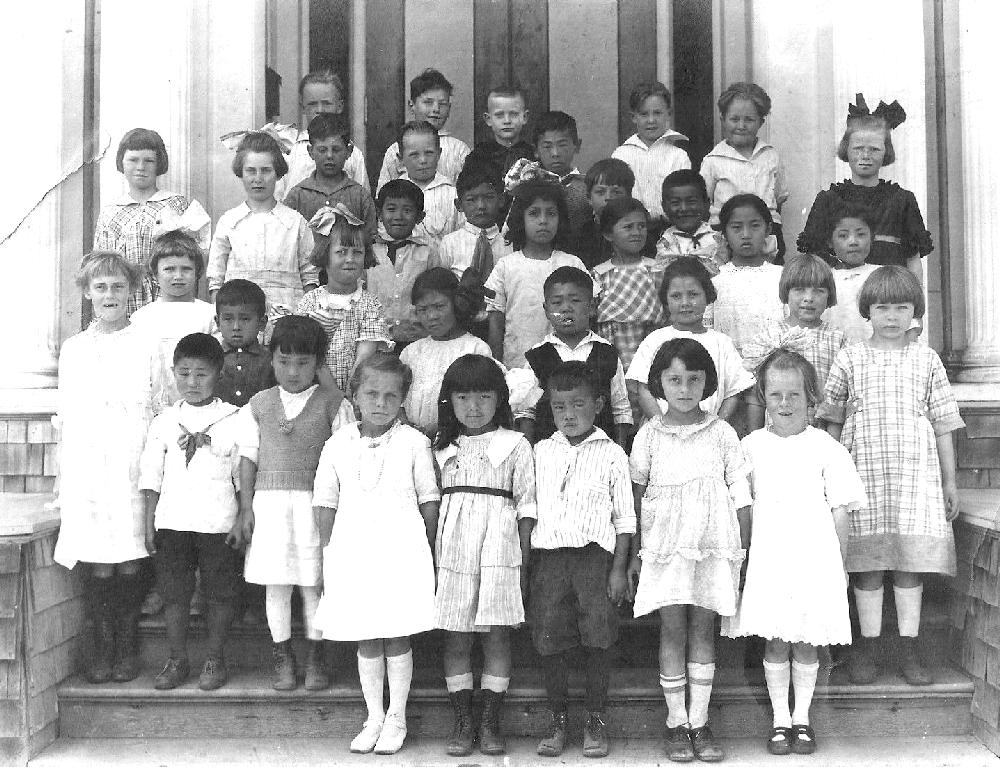
Unidentified Alameda Elementary School (1922)

Figure 1.--Most of the Japanese Americans living on the mainland lived in California. Alameda was an island across the Bay from San Francisco. Alameda is one of the many places in California with a Japanese community, called Japantown at the time. Interestingly, the San Franciso terminus of the famed China Clipper was located at Alameda. Some Issei (first generation) settled in Alameda and created a Japantown roughly bounded by Park Street, Santa Clara Avenue, Walnut Street and the Oakland Estuary. This school would have been located in that area. The Issei started schools for their children, but Sensi (third generation) like these children were more likely to attend public schools, although they also went to the Alameda Gakuen--Japanese language school. Notice there is no duffrence in how the Japanese and other children dressed. The photograph was taken in May 1922 at the end of he school year. The photograph comes from the Photo Service Bureau in Alameda.
|
|
Most of the Japanese Americans living on the mainland lived in California. Alameda was an island across the Bay from San Francisco. Alameda is one of the many places in California with a Japanese community, called Japantown at the time. Interestingly, the San Franciso terminus of the famed China Clipper was located at Alameda. Some Issei (first generation) settled in Alameda and created a Japantown roughly bounded by Park Street, Santa Clara Avenue, Walnut Street and the Oakland Estuary. This school would have been located in that area. The Nisei and Sensi (second and third generation) were mostly born in America and thus U.S. citizens. The Japanese community in Alameda opened a Buddhist Temple on Buena Vista Avenue. Many who converted to Christianity attended the Alameda Methodist South Church. The Issei started schools for their children, but Sensi were more likely to attend public schools, like these children. Although they also went to the Alameda Gakuen--Japanese language school. Notice there is no duffrence in how the Japanese and other children dressed. This was the same pattern observed with other immigrant groups and is an indication of assimilation. Japantowns formed because of restrictions on Japananese property ownership and the desire to live in a community. The Issei looked somewhat diapprovingly on the Americanization of their children and grandchildren. By the 1930s there were some 900 ethnic Japanese living in Alameda. The class here looks to a First Grade class at the end of the school year. About a third are ethnic Japanese. After the Japanese World War II Japanese enternment, the restrictions on Japanese property ownership as well as education and job discrinination rapidly disappeared and thus Japantowns did not reappear.
HBC-SU

Related Chronolgy Pages in the Boys' Historical Web Site
[Return to the Main American school activities page]
[Return to the Main American 1920s page]
[Return to the Main Chronology Page]
[The 1900s]
[The 1910s]
[The 1920s]
[The 1930s]
[The 1940s]
[The 1950s]
[The 1960s]
[The 1970s]
[The 1980s]
[The 1990s]
[The 2000s]
Navigate the Relate Boys Historical Clothing Style Pages
[Return to the Main country page]
[Long pants suits]
[Short pants suits]
[Lederhosen]
[Kneesocks]
[Eton suits]
[Jacket and trousers]
[Blazer
[School sandals]
[Bloomers]
[Rompers]
Navigate the HBC School Section
[Return to the Main U.S. individual school 1920s chronology page]
[Return to the Main national school page]
[Return to the Main Japanese immigration page]
[About Us]
[Activities]
[Chronology]
[Clothing styles]
[Countries]
[Debate]
[Economics]
[Garment]
[Gender]
[Hair]
[History]
[Home trends]
[Literary characters]
[School types]
[Significance]
[Transport and travel
[Uniform regulations]
[Year level]
[Other topics]
[Images]
[Links]
[Registration]
[Tools]
[Return to the Historic Boys' School Home]
Created: 2:44 PM 9/17/2017
Last updated: 2:44 PM 9/17/2017




